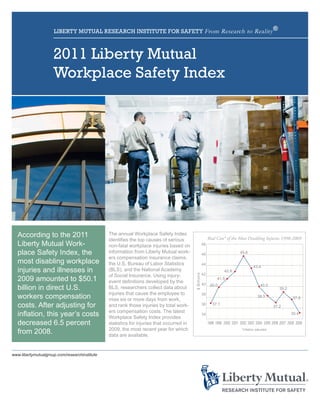
Liberty mutual insurance workplace safety index 2011
- 1. LIBERTY MUTUAL RESEARCH INSTITUTE FOR SAFETY From Research to Reality ® 2011 Liberty Mutual Workplace Safety Index According to the 2011 The annual Workplace Safety Index Real Cost* of the Most Disabling Injuries 1998-2009 identifies the top causes of serious Liberty Mutual Work- non-fatal workplace injuries based on 48 place Safety Index, the information from Liberty Mutual work- 46 45.6 ers compensation insurance claims, most disabling workplace the U.S. Bureau of Labor Statistics 44 43.4 injuries and illnesses in (BLS), and the National Academy 42 42.8 of Social Insurance. Using injury- $ Billions 2009 amounted to $50.1 event definitions developed by the 41.5 40 billion in direct U.S. BLS, researchers collect data about 40.0 40.0 39.2 injuries that cause the employee to workers compensation miss six or more days from work, 38 38.5 37.8 costs. After adjusting for and rank those injuries by total work- 36 37.1 37.2 ers compensation costs. The latest inflation, this year’s costs Workplace Safety Index provides 34 35.4 decreased 6.5 percent statistics for injuries that occurred in 1998 1999 2000 2001 2002 2003 2004 2005 2006 2007 2008 2009 2009, the most recent year for which from 2008. data are available. *inflation adjusted www.libertymutualgroup.com/researchinstitute
- 2. Overexertion1 Top Five Injury Causes Top 10 Causes of Disabling Injuries in 2009 $12.75 ($ in Billions) The top five injury causes – overexer- 25.4% tion, fall on same level, fall to lower Fall on same level, bodily reaction, and struck by level object – accounted for 71.7 percent of $7.94 the total 2009 cost burden. Overexer- 15.8% Fall to Bodily tion maintained its first-place rank. This lower level Reaction Struck by 2 object3 event category, which includes injuries $5.35 $5.28 Assault/ related to lifting, pushing, pulling, hold- $4.64 Caught in/ Struck 10.7% 10.5% Violent 9.3% Highway Compressed against Repetitive act ing, carrying, or throwing, cost busi- incident by object4 motion5 $0.59 nesses $12.75 billion in direct costs $2.18 $2.04 $2.01 $1.97 1.2% and accounted for more than a quarter 4.3% 4.1% 4.0% 3.9% of the overall national burden. Fall on 1 Overexertion – Injuries from excessive lifting, pushing, pulling, holding, carrying, throwing same level ranked second as a leading 2 Bodily reaction – Injuries from bending, climbing, reaching, standing, sitting, slipping or tripping without falling 3 Struck by object – Such as a tool falling on a worker from above cause of disabling injury. With direct 4 Struck against object – Such as a worker walking into a door costs of $7.94 billion, this category 5 Repetitive motion – Injuries due to repeated stress or strain accounted for 15.8 percent of the total injury burden. Fall to lower level ranked third at $5.35 billion in costs. Bodily reaction, which includes injuries resulting from free bodily motion such as bending, climbing, reaching, standing, sitting, and slipping or tripping without falling, ranked fourth at $5.28 billion. Struck by object took the fifth- place ranking at $4.64 billion. Remaining Injury Causes The remaining five injury causes in the top 10 each accounted for less than 5.0 percent of the direct cost of disabling injuries in 2009. Highway incident represented 4.3 percent of the total injury burden at $2.18 billion; caught in/compressed by (injuries resulting from workers being caught in or compressed by equipment or objects) accounted for 4.1 percent of the total injury bur- den at $2.04 billion; struck against object accounted for 4.0 percent at $2.01 billion; repetitive motion, with related injuries, accounted for 3.9 percent of the cost burden at $1.97 billion; and assault/violent act accounted for 1.2 percent at $0.59 billion. Real Growth Trends 1998-2009 (Percent change by category) Overall, the top 10 cause categories comprised 89.3 percent of the entire cost burden 34.2 Fall same level of disabling work-related injuries in 2009. 10.2 Fall lower level 9.4 Bodily reaction Real Growth Trends 1998 to 2009 5.9 Struck by object The overall real (inflation-adjusted) direct costs of disabling workplace injuries 3.4 Assault/Violent act decreased 4.6 percent between 1998 and 2009. However, fall on same level, fall to -1.1 Caught in/Compressed by lower level, bodily reaction, struck by object, and assault/violent act increased by 34.2, 10.2, 9.4, 5.9, and 3.4 percent, respectively (see chart, right). During this same -9.9 Overexertion period, the real cost of disabling caught in/compressed by injuries decreased 1.1 per- -13.4 Struck against object cent; overexertion injuries decreased 9.9 percent; and struck against object, highway incident, and repetitive motion also showed cost declines, dropping 13.4, 19.8, and -19.8 Highway incident 40.0 percent, respectively. -40.0 Repetitive motion To learn more about the Liberty Mutual Research Institute for Safety and its programs, or to download Scientific Updates and our Annual Report of Scientific Activities, visit our website at www.libertymutual.com/researchinstitute. Liberty Mutual Research Institute for Safety | 71 Frankland Road | Hopkinton, MA 01748 USA